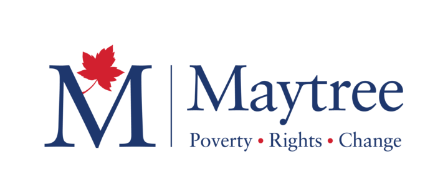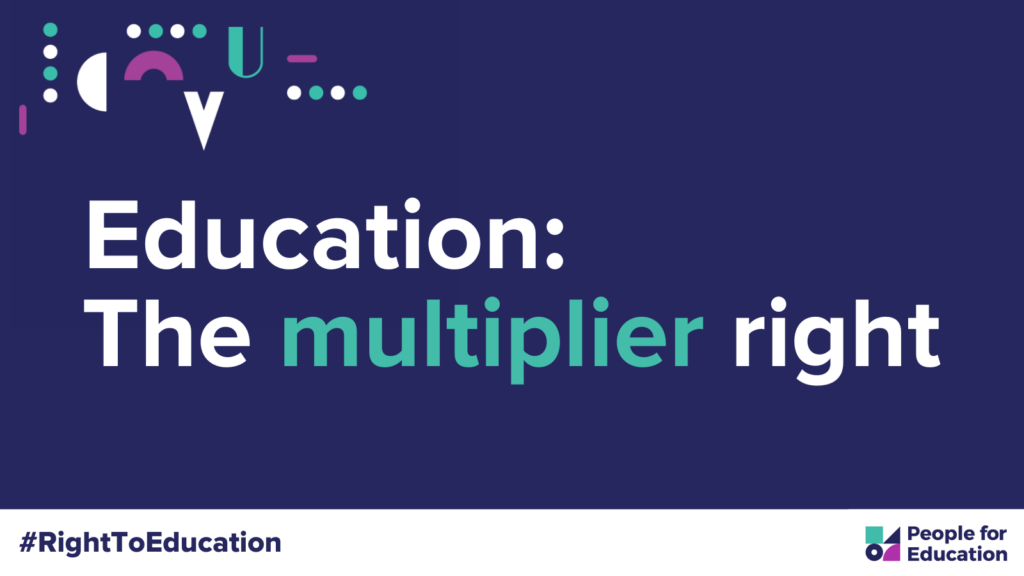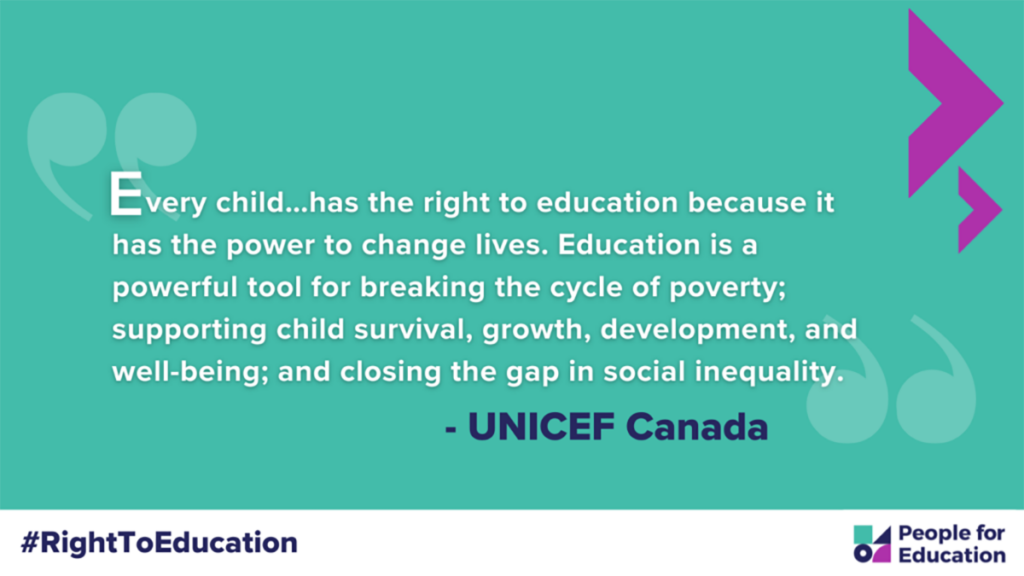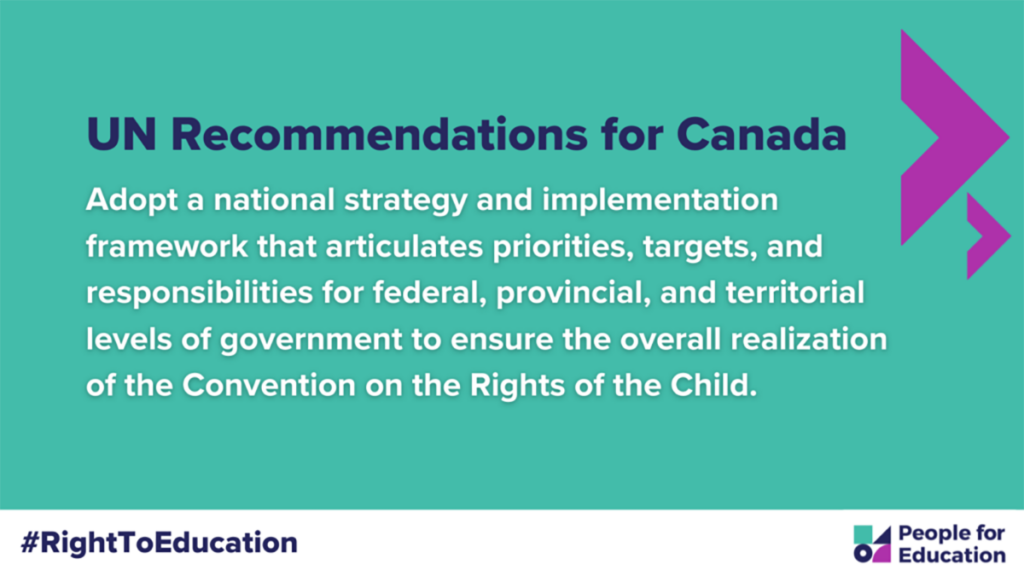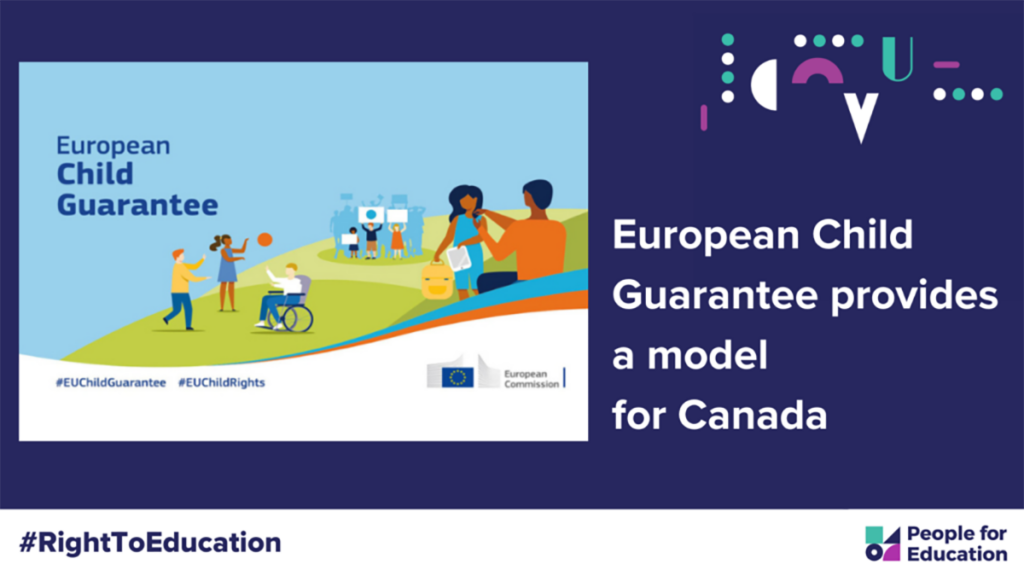The Right to Education
People for Education’s Right to Education Framework
People for Education’s Right to Education Framework has two key purposes:
To define a quality education in Canada by articulating clear goals and outcomes
To provide sample indicators that can be developed, measured, and publicly reported by schools, boards, policymakers, and education systems
In Canada, a quality education fulfils four key goals:

Every child has equal ACCESS to all educational resources.
Learn More
Every student has AGENCY to play an active role in their education.
Learn More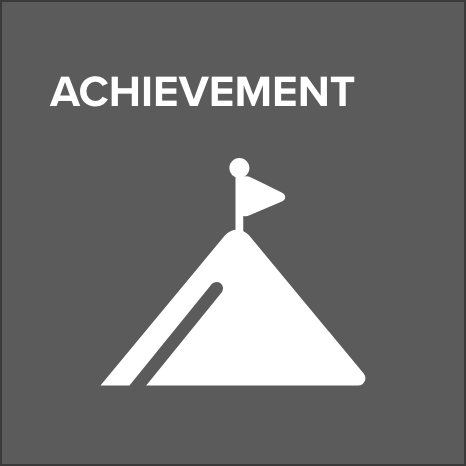
Every graduate is set for long-term ACHIEVEMENT.
Learn More
Every system is ACCOUNTABLE to all students' rights to education.
Learn MoreAccess
Outcomes
- Early childhood education is part of the publicly funded education system.
- Students can participate in curricular and extracurricular activities that reflect their interests
- Schools provide personalized and timely accommodations for students with disabilities.
- Students have trained professionals and programming to support any aspect of their well-being and development (e.g., mental, physical, emotional spiritual).
- Schools offer interpretation and translation services for all communications with families.
- The use of technology enables, supports, and enhances student learning.
Indicators*
- % of students who attended early childhood education programs between the ages of 0-4
- % of students who received targeted early learning supports
- % of students who accessed school-based services to support any aspect of their well-being and development (e.g., mental, physical, emotional, spiritual)
- % of schools that have implemented activities that promote community relationships, including curricular and extra-curricular activities
- % of student enrollment in all course types in Grades 10, 11, and 12 (e.g., Locally Developed, Open, Essentials, Workplace, Registered Apprenticeship Program, University, College, etc.)
*All data collected must have the capacity to be disaggregated by the following demographic variables: race, disability, special needs, 2SLGBTQIA+ self-identification, Indigenous self-identification, and socio-economic status.
Agency
Outcomes
- Students understand their human rights and treaty rights.
- Students have the option to learn in English, French, or an Indigenous language.
- Indigenous communities lead the creation, development, and implementation of their curricula.
- Students are part of decision-making discussions about the school administration, environment, culture, classrooms, and communities.
- There is a mandatory process in place to consult with students or families before decisions are made to change a student’s education track (i.e., streaming), program, or disciplinary response.
Indicators*
- Proportion of students who
- report they see themselves reflected and affirmed in their learning (Grades 4-12)
- feel their school is a safe and inclusive environment (Grades 4-12)
- report feeling comfortable seeking supports for their mental health and well-being (Grades 4-12)
- report feeling a strong sense of belonging to their school community (Grades 4-12)
- have an individual education plans that is updated annually (e.g., Individual Pathways Plan, Individualized Program Plan, etc.)
*All data collected must have the capacity to be disaggregated by the following demographic variables: race, disability, special needs, 2SLGBTQIA+ self-identification, Indigenous self-identification, and socio-economic status.
Achievement
Outcomes
- Every student, regardless of any aspect or intersection of their identities, graduates from secondary school.
- Graduates have the transferable skills and global competencies that they need to embark on diverse post-education pathways.
- Graduates are engaged and contributing citizens in the world of work and lifelong learning.
Indicators*
- Student attendance rates
- High-school graduation rates
- Proportion of educators participating in subject-specific professional development
- Proportion of students reporting confidence in their preparedness for post-graduation options entering a university program, college program, apprenticeship training program, or other post-secondary institution after secondary school
*All data collected must have the capacity to be disaggregated by the following demographic variables: race, disability, special needs, 2SLGBTQIA+ self-identification, Indigenous self-identification, and socio-economic status.
Accountability
Outcomes
- Educators have the most up-to-date qualifications and training required to support student learning.
- Schools have a clear process for students to claim their rights to a quality education.
- Equity and anti-racism are explicitly addressed in every school’s strategic plan, which includes actions, monitoring, evaluation, and reporting.
- All educators and school administration have completed training on why this is important and how they support this work.
- Provinces/territories, school boards, and schools annually collect data and publicly report on the indicators of a quality education.
Indicators*
- Proportion of school boards that:
- collect and publicly report education data disaggregated by identity-based variables
- have implemented an anti-racism strategy
- Proportion of schools that have an intentional strategy to improve student, family, and community engagement
- Proportion of school administrators and staff who have completed training on human rights, equity, and anti-racism
- Number of student suspensions and expulsions
*All data collected must have the capacity to be disaggregated by the following demographic variables: race, disability, special needs, 2SLGBTQIA+ self-identification, Indigenous self-identification, and socio-economic status.
Why does Canada need a Right to Education Framework?
In Canada, everyone has a right to education, but that right is currently neither adequately defined, nor equitably accessible.
Canada is recognized as home to some of the best publicly funded education systems in the world, but persistent gaps and barriers mean that not every child or student has equitable access to the quality education that will provide them the chance for long-term success in school and life.
Imagine a Canada where every child and young person lives the vision outlined in the UN Convention on the Rights of the Child: a world where every child is guaranteed the right to an education that grants them “an equal opportunity to develop [their] abilities, [their] individual judgement, and [their] sense of moral and social responsibility, and to become a useful member of society.”
Defining the right to a quality education will ensure that that every child and young person has access to an education that prepares them with the wide range of skills and competencies they need to become capable human beings with an equitable chance for long-term success and the capacity to participate in democratic society.
How was this framework developed?

In 2018, with support from the Maytree Foundation, People for Education convened an advisory group of human rights experts to guide the creation of this framework. In 2020, a week-long workshop in partnership with the Students Commission of Canada was held where youth drafted their own recommendations for the right to education. These recommendations led to the first draft framework, which was released in 2020, followed by Canada-wide consultations with education stakeholders, youth, and the public. Over 350 individuals and organizations from across Canada participated in the consultations including educators, government officials, policy makers, researchers, students, and parents. Feedback from these consultations, along with continued guidance from our advisory group, led us to the current framework; however, this work is an ongoing, iterative process that recognizes the following:
“Quality education is a dynamic concept that changes and evolves with time as well as the social, economic, and environmental context.” – UNESCO
What else must be done?
Children do not enter the world on equal footing. Socioeconomic status, race, culture, and geography are only some of the factors that dictate a child’s experiences and privilege, or lack thereof, in society. For the Right to Education Framework to effectively support all students, it must focus on disrupting the existing tensions and contradictions between the idealistic outcomes of a quality education and the inequitable status quo.
Frequently Asked Questions
Why does a right to education matter?
Education is foundational to all our human rights. Human rights are guaranteed to us no matter who we are, and include civil and political rights, as well as economic, social, and cultural rights. These rights are – as the UN High Commissioner for Human Rights says – “interdependent, interrelated, and indivisible.”
Why is education called a multiplier right?
The right to education is a “multiplier” right, in that it enables us to access our other human rights. It enables the right to freedom of expression, the right to freedom of association, the right to political participation, the right to vote, the right to freedom of thought, conscience and religion, and the right to family and private life. According to the UN Committee on Economic, Social and Cultural Rights, it is also “the primary vehicle by which socially and economically marginalized adults and children can lift themselves out of poverty.”
How does this work connect to equity?
Rights are inextricably linked to equity. Every person has the right to non-discrimination, and the human rights principle of universality embeds the right to equity. The principle of equity acknowledges and recognizes that historically there are populations who have been underserved, underrepresented, and discriminated against, and that closing gaps in the enjoyment of rights is necessary to achieve equitable outcomes in education and life. A rights-based education framework helps recognize the goals of equity as an obligation within a framework of accountability. It is one of the many strategies that can be used to address continued inequities not only in access, but in students’ rights to equitable outcomes and success in education.
What is a rights-based framework?
Every person in Canada has a range of economic, social, and cultural rights. In addition, Indigenous peoples in Canada have specific treaty-based rights and inherent rights, as well as rights articulated in the UN Declaration on the Rights of Indigenous Peoples.
Rights-based frameworks help to define in specific terms what types of supports and services people should expect to receive within our economic and social systems. These frameworks can help governments and individuals re-imagine both how systems are structured and how well they are serving the individuals and communities they are meant to serve.
Once a framework is agreed to, then are all the rights in it guaranteed?
Having a rights-based framework does not mean that every right is achieved overnight, but it does provide a tool to track systems’ or jurisdictions’ progress toward achieving a defined set of goals. This concept – of “progressive realization” of rights – is enshrined in the International Covenant on Economic, Social and Cultural Rights. It means that once a set of rights are agreed upon, states must show that they are taking steps toward the full realization of those rights, using their maximum available resources. In this way, rights-based frameworks can be used to guide progress and to hold jurisdictions accountable.
How could this framework support a right to education?
Unlike most countries, Canada does not have a national department of education. Control over education resides with the provinces and territories and First Nations peoples. Furthermore, Canada has relatively strong education systems; however, persistent gaps and barriers mean that not every child or student has equitable access to the quality education that will provide them the chance for long-term success in school and life. Notably, systemic racism, underfunded on-reserve education, and the lack of universal early childhood education continue to undermine equity in education.
The creation of a Right to Education Framework supports the advancement of rights outlined in existing Canadian legislation (e.g., Canadian Charter of Rights and Freedoms) and in international rights agreements that Canada has signed, such as the Convention on the Rights of the Child. A rights-based education framework helps recognize the goals of equity as an obligation within a framework of accountability. It is one of the many strategies that can be used to address continued inequities not only in access, but in students’ rights to equitable outcomes and success in education.
By articulating a definition for a quality education in Canada, the Right to Education Framework not only establishes common goals for education systems, but also provides a mechanism for tracking our progress towards the realization of these goals.
Who can use the Right to Education Framework?
You can! This framework can be used by everyone: whether it’s to learn about the components of a quality education, to teach about human rights-based approaches, a resource used to start a conversation, or a tool to ask questions about access, agency, achievement, and accountability.
A Right to Education Framework could also be used by multiple levels and types of government and governing structures, including federal, provincial, territorial, Indigenous, municipal, school board and schools. It would introduce a consistency across the country in terms of the quality of education every person in Canada should expect. The Framework would also serve to harmonize education-related standards across the different systems, while at the same time providing a structure that could be adaptable to local and regional needs.
How could a Right to Education Framework uphold Indigenous rights?
It is critically important to distinguish Indigenous rights from a universalizing human rights framework. For Indigenous students, the right to education is a human rights issue, as well as an issue of inherent Indigenous rights and treaty rights. The People for Education Framework recognizes existing standards for Indigenous education developed by Indigenous-led organizations such as the World Indigenous Nations Higher Education Consortium (WINHEC), which has developed standards and benchmarks for both K–12 and post-secondary Indigenous educational institutions. International human rights instruments are to support and not to revoke or rescind the self-determining and inherent rights systems of Indigenous Peoples.
Feedback
"*" indicates required fields
This project is funded by
